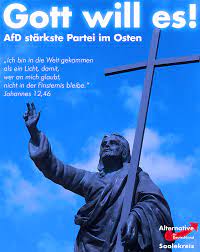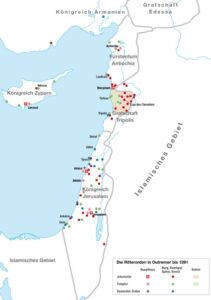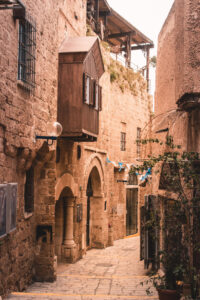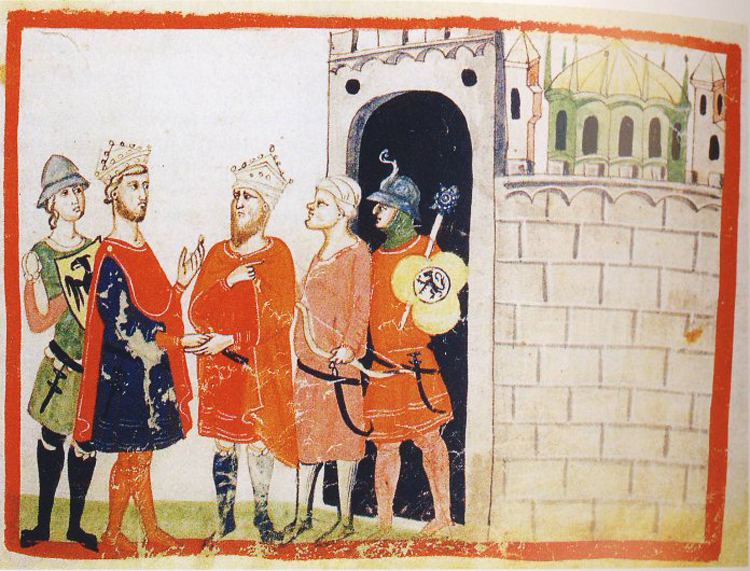Articles
The Crusades: between religion and politics, fiction and reality
Article author: Alejandro Manjón
Date of publication of the article: 26/04/2021
Year of publication: 2021
The Crusades shaped the European Middle Ages, providing this chapter of History with an abundant religious zeal, which resulted in the expulsion of minorities, the expansion of Christianism and the flourishing of institutions such as the Inquisition throughout the Middle Age.

No matter how far away in time the Crusades might seem to us, coming off as an anecdotic story of our past, the references to these migrations marked by a religious factor have endured until this day through its presence in films (be it Amazon, Hollywood or Babelsberg Productions), but also in Western politics, where the Crusades are instrumentalized to exacerbate the “historic” conflict between Muslims and Christians. It is also utilized as a tool to emphasize the rejection towards Muslim immigrants and refugees, or towards people from majority Muslim countries. Some examples of this sort of politics can be appreciated in the propaganda of the German political party Alternative für Deutschland (AfD), as shown in the photo. The Spanish far right party Vox also makes use of this political strategy through their campaigns based on fake news.
The historical etymology of the Crusades
The first thing that needs to be taken into account is that the term “Crusades” was not used in the chronicles at the time. This term began to be used a couple centuries after they had taken place – a common thing among post eventum phenomena. The Latin chronicles separate the traveling aspect, referred as iter, via or expedition, from the actions that were done when the journey was over, upon arrival at the destination (negotium, bellum, opus or voluntas). Nevertheless, the designation ‘exercitus Dei’ and ‘milites Christi’ (God’s army and Christ warriors, respectively) can also be found to describe the journey and the negotium jointly.
The Crusades in their context
It is also necessary to point out that the Crusades not only took place in foreign lands, but also within the European continent. An example were the Baltic or the Albigensian Crusades, the latter being one of the most violent incursions in the Middle Ages on behalf of the Cross – it happened in Southern France and targeted Catharism.
The Crusades have never been anti-Muslim per se, in spite of the idea represented by the contemporary zeitgeist. It is important to highlight this matter because contemporary politics are sometimes accomplice of these distortions of the historical reality. They also manipulate the paradigm of the epoch for legitimation purposes, reinforcing the politicians’ ideas with allegedly historical facts – even though they have not been approved by the scientific community.
The Crusades have never been anti-Muslim per se, in spite of the idea represented by the contemporary zeitgeist.
Indeed, the more we dig deep into the complex world of the Middle Ages, the more we realize that the religious zeal, fundamental in the historical context of the Crusades, shared its importance with the Papacy’s political endeavors – along with the European reigns and industries. A clear example of this instrumentalization is the so-called Fourth Crusade, which ended in 1204 approximately. The expedition culminated with the conquest of the already Christian Constantinople, even though it was summoned by Pope Innocent III with the aim of conquering the Holy Land. Long story short: the Crusades were directly or indirectly a part of the political game back in the day.

Another noteworthy element was the scarce importance of the Crusades in the Middle East. In the Chronicles of Baghdad, once an important cultural and political center, there aren’t many texts on the Crusades, but rather marginal mentions without a clear idea as to why the Franks conquered Jerusalem. The Franks is the denomination given by the Muslims to the different European ethnicities.
Should we contextualize this historical phenomenon, we will reach the conclusion that the territories conquered by the Crusaders were limited to a reduced lot of coastal land of the later country of Syria. That is why it did not produce a huge reaction from the neighboring reigns. Moreover, the conquest and the settlement of the Franks did not translate in a structural rearrangement of the Middle East peoples. The cities that were indeed conquered did not produce a significative economic revenue – under which Jerusalem counts, a city which for diverse reasons was not cherished by Muslims back in the day, although it will be of great importance afterwards. Thus, its loss was not perceived as an event of vital significance at the time.
The supremacy of the political interests
It is true that from the 19th or even the 20th century onwards, the Crusades have been perceived with another nuance in the countries of Islamic majority. The Christian incursions were then linked with a proto-Colonialism, exacerbated by the historical reality of the Middle East during those centuries. To fully grasp the historical phenomenon of the Crusades, we need to have certain notions on the political map of the region. I will draw upon the geographical map of the Eastern Mediterranean in 1291, developed by the German publishing house Bayrischer Schulbuch.
When the Crusaders arrived and settled down in the coastal zone of the Eastern Mediterranean around the 9th century, an overall bewilderment prevailed as to the future of the Crusades once Jerusalem was conquered. Therefore, four Frankish settlements were created.
It might come off as a shock that these Christian and Islamic settlements coexisted peacefully. As a matter of fact, the Franks were accepted as part of the political situation at the time, concluding more than a hundred peace treaties. These four Frankish settlements and the Seljuks of Damascus and Aleppo agreed on an alliance in 1115 to protect themselves against the Seljuks of the North and the Fatimids of the Southeast – Egypt nowadays.
The sixth Crusade
As shown, the Crusades are a complex historical event to study due to its infinite ramifications. The most peculiar of them all was without a doubt the sixth Crusade, led by Frederick II. The king of Sicily and Germany had been declared a heretic after not complying with the orders of Pope Honorio III. As penitence he needed to crusade his way to Jerusalem under the name of God. After years delaying his departure, Pope Gregory IX excommunicated the monarch. It was then that he decided to embark himself into what was later named the sixth crusade, taking advantage of the friendship he had with the Ayyubid sultan Al-Kamil, which relationship will be explained in short. It is important to point out that Frederick II was raised in Sicily, an island whose elite was predominantly Muslim. Therefore, the king was not only tolerant towards the Islamic culture but also a great connoisseur of it. Furthermore, it is verified by a great number of sources that the monarch had vast knowledge of the Arabic language, an unusual characteristic amongst the European monarchs.

After having changed missives, gifts and words about theology, philosophy and biology, Al-Kamil decided to ask the European monarch for help. The plan was for Frederick II to settle in Jerusalem, creating a buffer zone between Al-Kamil’s Egypt and the Syria of his brother Muazzam. A biological bond did not hinder them from being enemies, something normal in the territories under Islamic influence due to the legacy of the Seljuk dynasty,which lasted until the year 1500 approximately. Frederick II received the news with enthusiasm. He would finally go to the Middle East to conquer Jerusalem. On the hand he would calm down the rage of the Pope and on the other hand, he would strengthen the ties with his Muslim ally.
After having changed missives, gifts and words about theology, philosophy and biology, Al-Kamil decided to ask the European monarch for help. The plan was for Frederick II to settle in Jerusalem, creating a buffer zone between Al-Kamil’s Egypt and the Syria of his brother Muazzam.
The role of Jerusalem

It is important to digress a moment in order to explain the role of Jerusalem. The city plays a fundamental role in the Crusades. However, both monarchs separate it from its religious context and instrumentalize the city as a bargaining chip for commercial purposes. The religious character of Jerusalem was not very important to Frederick II of Hohenstaufen. Indeed, it is plausible that the Occidental monarch was an atheist because he would indistinctively question Islamic and Christian precepts, even though he was an educated connoisseur of them both.
Due to life vicissitudes, in this case the death of Muazzam and the coronation of Al-Kamil’s nephew, An-Naser, the political configuration of the Eastern Mediterranean changed, and so did Al-Kamil’s intentions in his foreign policies. Syria was no longer a threat under the inexpert hands of his nephew. And trading Jerusalem to a Christian monarch would stir up great dissatisfaction amongst Muslims besides being unnecessary from a strategical point of view. Frederick II found himself amidst an unexpected problem. Returning back to Sicily empty-handed was not an option under the watchful gaze of the Pope.
In this context, the Treaty of Jaffa was signed, in which Frederick would be given the city of Jerusalem in exchange of a ceasefire to Egypt of ten years of duration. As it was to expect, that supposed a huge shock to the Muslim community, which rapidly stigmatized Al-Kamil as a traitor. The decision of the sultan is still discussed and tries to be conceived as a defensive maneuver because in those ten years Egypt was able to regenerate. Nevertheless, the doubt of the Treaty’s efficiency thrives and there are plenty of theories concerning its meaning.
Conclusion
The Crusades, that fervor of the Christian expansionism propelled by the highest political and religious echelons, has been and still is a crucial milestone in the European historical conscience, which is still instrumentalized to satisfy diverse contemporary fields. This is why it is important to observe and understand this religious sociopolitical phenomenon for what it was, disassociating ourselves from the modern attributions that tear them apart from their natural context, twisting the historical facts to satisfy the modern paradigm.
References
Housley, Norman: Contesting the Crusades, Oxford 2006 pg 1-23
Köhler, Michael A.: Allianzen und Verträge zwischen fränkischen und
islamischen Herrschern im Vorderen Orient: eine Studie über das zwischenstaatliche
Zusammenleben vom 12. bis ins 13. Jahrhundert, Berlin 1991 pg 54-69
Chamberlain, Michael: Military Patronage States and the Political Economy
of the Frontier, 1000-1250, in: Y.M. Choueiri (Hg.): A Companion to the History of the
Middle East, Malden, MA 2005 pg.135- 153
Hirschler, Konrad: The Jerusalem Conquest of 492/1099 in the Medieval
Arabic Historiography of the Crusades: From Regional Plurality to Islamic Narrative, in:
Crusades 13 (2014) pg.37- 76
Ellenblum, Ronnie: Frankish Rural Settlement in the Latin
Kingdom of Jerusalem, Cambridge 1998 pg. 3 -38
Friedman, Yvonne: Peacemaking: Perceptions and
Practices in the Medieval Latin East, in: C. Kostick (Hg.): The Crusades and the Near
East. Cultural Histories, London 2011 pg 229-257
Ibn al-Athīr, al-Kāmil fī al-taʾrīkh (Richards: The Chronicle of
Ibn al-Athir for the Crusading Period from al-Kamil fi ‘l-ta’rikh, Part 1: The years 491-
541/1097-1146: The Coming of the Franks and the Muslim Response, Aldershot 2006,
138-141).
Leder, Stefan: Sunni Resurgence, jihād Discourse and
the Impact of the Frankish Presence in the Near East, in: S. Leder (Hg.): Crossroads
between Latin Europe and the Near East: Corollaries of the Frankish Presence in the
Eastern Mediterranean (12th-14th centuries), Würzburg 2011 pg. 81-101
Flood, Finbarr B.: An Ambiguous Aesthetics: Crusader
Spolia in Ayyubid Jerusalem, in: R. Hillenbrand/S. Auld (eds.): Ayyubid Jerusalem: The
Holy City in Context 1187-1250, London 2009, S. 202-215.
Jotischky, Andrew: Pilgrimage, Procession and Ritual
Encounter between Christians and Muslims in the Holy Land, in: K. Jensen/H.Vogt/K.
Salonen (eds): Cultural Encounters During the Crusades, Odense 2013, S. 245-62.
Abu-Munshar, Maher: Sultan al-Kamil, Emperor Frederick II and the Submission of Jerusalem, January 2013International Journal of Social Science and Humanity , Qatar University
Maalouf, Amin; Las Cruzadas vistas por los árabes, Cápitulo XII
Mallet, Alex: Franks, Enciclopedia del Islam III


